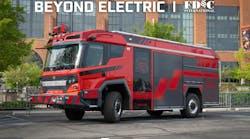Wireless transmitters are an accessory or feature offered by nearly every thermal imaging manufacturer. While these transmitters vary widely from manufacturer to manufacturer with performance, features, number of channels, size, weight, transmitted distance and price, many fire departments struggle with what to do with the information they provide. Departments buy wireless transmitters to be used for a specific purpose such as providing information to the incident commander, but either the system doesn't perform well or it's not used consistently for the idea to take hold. What usually happens is that the transmitters and receiver get shelved or forgotten. When this happens, your investment and potential benefit are lost.
In this column, we will look at the various ways transmitted thermal imagery can be utilized at an incident:
- Incident command - An incident commander (IC) should have access to as much information as possible. At the incident scene, there is no such thing as too much information. Whether the IC uses the information is less important than whether it is available. Interior conditions and crew activities can be monitored by the IC when wireless video is available. A receiver system designed for placement with the IC should be large enough to be easily viewed by not only the IC, but others who are also stationed at the command post. Some receiver systems allow for recording at the receiver so the IC could record the incident or portions thereof for documentation and/or training purposes.
- Safety officers - Safety officers (SOs) typically roam the fire scene looking for and mitigating hazards in an effort to promote the safety of the scene and reduce the risk of injury. SOs can use wireless thermal imagery to get a better feel for the fire or environmental conditions inside the structure and add that information to their plan as they evaluate the building from the outside for structural integrity. Because the SO is mobile, the receiver selected should be smaller, handheld and designed for viewing by one person at a time. This added mobility means that the SO can continue to contribute to overall incident safety without being tethered to a larger, more cumbersome receiver system.
- Hazardous materials - Receiving transmitted thermal imagery allows for those outside the "hot zone" to view, in real time, what those inside that zone are seeing. Obviously, the many uses of a thermal imager in hazmat are beyond the scope of this column; however, vital information can be obtained with the thermal imager, and transmission can greatly speed the transfer of this information. This receiver unit should be configured much like the IC receiver, including recording functions. Documentary recording can become important in hazmat situations.
- Rapid intervention - When placing a receiver, you should place it with the officer of your rapid intervention team (RIT). This person can monitor multiple interior crews. The RIT officer can monitor the paths taken through the structure by the interior crews and track what room they are operating in and what tasks they are involved with. Should a Mayday ring out, the RIT crew has a jump start on the rescue information. The RIT officer can take the receiver into the structure during the rescue to monitor the activity of the troubled crew while the RIT is making their way in. Details such as simple imager movement may indicate that the troubled crew is moving and conscious. The RIT officer should be equipped with a small, handheld and highly mobile receiver.
Unfortunately, your choices in transmission systems are limited. Each manufacturer has its own wireless system, which is typically proprietary to that manufacturer. While you may be able to mix and match another manufacturer's receiver, you are typically stuck with the transmitter that the manufacturer offers. Because the transmitter attaches directly to the thermal imager, you simply don't have any options. However, once the thermal imagery is "transmitted" you can use any receiver that happens to utilize the same frequency as the transmitter. Some larger cities that already operate modern mobile communications vehicles may be able to dial-in the transmitted frequency in a programmable receiver and not need to acquire a separate receiving system for the IC.
Check with your imager manufacturer and see what is available. Remember that you are not limited by the number of receivers on any given scene. You are simply limited by the number of transmitters. If you were to equip two companies with transmitters, you could position receivers with the IC, SO, RIT, rehab or anywhere you desire. Some cities are working now to receive and re-transmit wireless thermal imagery so that it can be viewed at a remote command post.
Wireless transmission can provide valuable information to those that could use it on any given incident scene. Proper implementation takes a little bit of thought, planning and practice, but the ability to widely and instantly disseminate interior information at a rapidly changing fire scene can be well worth the investment.
BRAD HARVEY is the Thermal Imaging Product Manager at Bullard. He is a veteran of public safety as a firefighter, police officer and paramedic and is certified through the Law Enforcement Thermographers' Association (LETA) as a thermal imaging instructor. Harvey has worked as a high-angle rescue instructor and is a certified rescue technician and fire instructor. If you have questions about thermal imaging, you may e-mail him at [email protected].





